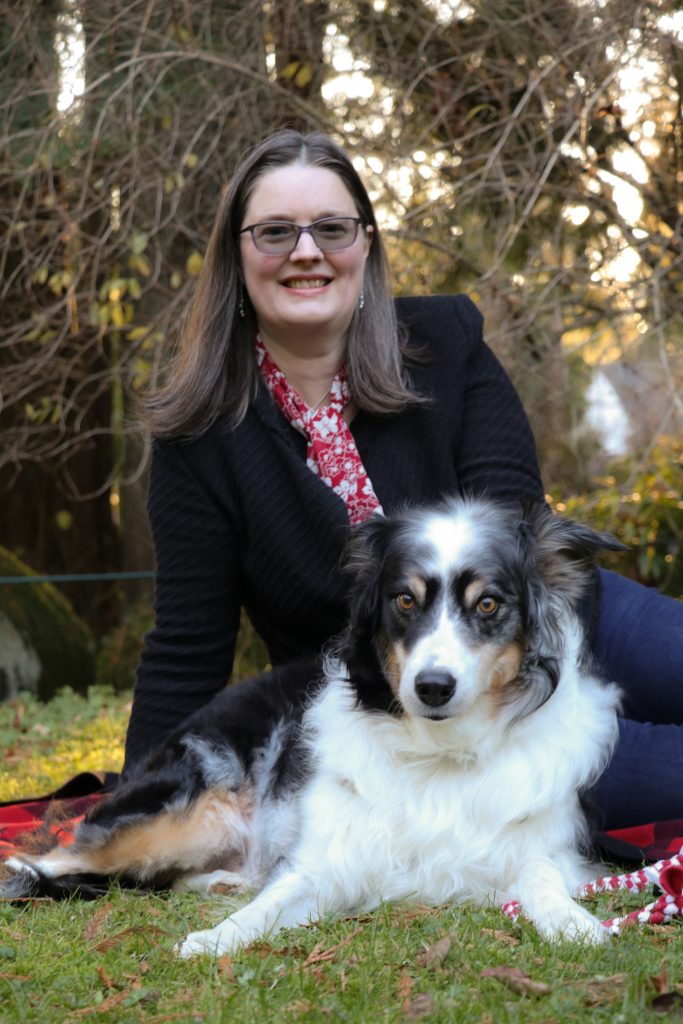Accepting who your dog is
Bark! The Science of Helping Your Anxious, Fearful, or Reactive Dog
by Zazie Todd
Vancouver: Greystone Books, 2024
$36.95 / 9781778401367
Reviewed by Jessica Poon
*

I once had a vet cavalierly quip to me: “Who doesn’t need a little Prozac?” For better or for worse, this jocular opinion did not result in a prescription for either myself nor my dog.
“Dogs are the new kids,” a friend of mine once said. “And plants are the new dogs.” He did not
specify who the new plants were, though, which struck me as a curious omission. Spanking is, hopefully, not as de rigueur as it used to be in parenting, though I confess that the old proverb about the oppressed seeking to be the oppressors is relevant when I recognize how unreasonably resentful I am of children who have never been spanked (yes, I have issues). And, tangentially, dominance and/or alpha-based dog training is increasingly recognized and scientifically proven to cause more problems than it solves. Anxiety is not unique to humans—arguably, not many things are—and dogs, ever beloved, are often anxious. If you love dogs, or have a dog with anxiety, then you will appreciate Zazie Todd’s book, Bark!, a compassionate, helpful book for owners seeking guidance for how best to help their fearful and/or anxious dogs. Continuously, Todd emphasizes that dominance-based training is both outdated and deleterious.
Todd states “It’s okay to comfort a fearful dog.” I found this gratifying. In many ways, dog behavior and/or dog training advice is reminiscent of basic human psychology. Expecting, for instance, young boys to toughen up and to conform to machismo culture, is not serving them, nor anyone else. Acknowledging feelings and feeling safe enough to express them is important—for humans and dogs alike. Dogs have their own feelings; humans can help dogs with their feelings. After all, dogs help us with their feelings (isn’t that why we got them?).
Similarly to what bioethicist and writer Jessica Pierce writes about dogs needing more agency, Todd writes that “Dogs should be able to make choices and have control over their lives, as far as possible. Another drawback of old-fashioned ideas about dominance is that people expect their dog to always do what they’re told.” Perfect obeisance might sound good on paper; however, people don’t generally acquire dogs for the express hope of inviting an automaton into their lives. Some of the most luminously joyful moments of having a dog are when they are expressing agency, disobedience, and mischief! Dogs are humbling that way. Todd shares an engaging anecdote about when a dog of hers was comfortable enough to steal food from the kitchen, which required some ingenious maneuvering. Rather than getting upset, she realized that the food stealing was a sign of feeling comfortable in the home—a good thing.

Todd writes that “It’s the dog’s perception that counts. It can be hard to understand why a dog is scared of something, but that fear doesn’t have to make sense to us. … It doesn’t matter if the fear seems stupid; the point is that the dog is afraid. We should acknowledge that and figure out what to do about it. Ignoring it, just because the fear seems daft, is not a solution.” Frankly, what she writes about the dog’s perception mattering would apply just as well to human beings. I was prompted to think about how often we think we need to understand something to accept it. This, simply, is not true. We can accept something without empirical understanding and we can meet it with compassion; we can listen. All too often, I hear dog owners describe perfectly normal dog behaviour—their dog wanting to meet other dogs, their dog being scared of other dogs, their dog eating poop—as “weird”—the word is being used disparagingly, self-consciously, and with little awareness to the dog’s point of view. If we don’t have the answer to why, but we still observe something causing a dog distress, we ought to pay attention. It is possible we will never get the answer to why. But we can still help our dogs.
Todd writes extensively about how to train a fearful dog. It will likely not surprise any dog lover that, by and large, it comes down to treats and timing (and patience!). She explains operant conditioning (learning new things), classical conditioning, counter conditioning, desensitization, and the importance of planning. Todd also reminds us that: “Remember, it’s perfectly okay to give your dog treats for no reason … Feel free to spoil your dog.” For about half a second in my life, I subscribed to Nothing in Life is Free in Sophia Yin’s Learn to Earn program and while I don’t deny it probably works well for some, I found it oppressively rigid and massively unfun. Maybe giving a dog a treat for “no reason” seems like a participation trophy in elementary school, but I promise you, it is not.
Todd discusses the most common dog fears: other people, other dogs, loud noises, vet visits, being left alone, their things being taken away (resource guarding), and dysfunctional repetitive behaviours. She goes over mistakes that are easily made in training—for instance, overdoing an exposure that is intended to be counter-conditioning, as well as imprecise timing. For me, when my dog was terrified of buses, I had to be extra careful in gauging how far away a bus had to be for her to be in any state to even accept a treat. In the greatest depths of fear, refusing treats, or accepting treats with a harder bite than usual, is a sign of anxiety. The process was gradual. There were instances where it seemed my dog had completely overcome her fear of buses and I was overjoyed; there were instances when a bus essentially meant both training time and the walk was over, which left me feeling like a failure. Those days were difficult. But accepting that process is seldom, if ever, linear—and involves setbacks, which are educational—was crucial. I’m still working on that. That’s the thing—teaching your dog is not a one-sided process, but a beautiful symbiosis of time, effort, and mutual love. Teaching your dog means doing a lot of learning yourself.
Todd writes about caregiver burden, which “involves negative emotions such as stress, anxiety, and depression, as well as impacts on finances and time. … Recognize that you may need time to process some of the emotions you have about your dog and the situation. … It’s easy to miss progress when it happens in small increments. … It helps to know that setbacks are a normal part of learning. Your dog isn’t the only one learning: you are too. … When people have a reactive dog who “goes off,” they can feel stressed, guilty, nervous, frustrated, sad, heartbroken, and like they’ve let their dog down. Many people say that treating the setback like a learning opportunity can help. Say to yourself, “Okay, so something went wrong, but what can I learn from it?” And remember that, since your dog has made progress before, they can make it again.”

Todd discusses complementary therapies such as a Thundershirt and CBD oil, though she emphasizes that none of these are meant to replace management and training. Given that dogs are highly variable sentient beings with their own unique pasts and idiosyncrasies, it’s worth noting that Todd writes: “One of the things that dog trainers often say is that there are no guarantees with behaviour. (If your dog trainer claims there are, it’s not a good sign.)” She vociferously discourages the use of prong collars and other similarly aversive methods. Having often been the unwilling recipient of misguided, scientifically inaccurate dog training advice from antediluvian white men, my tolerance for simplistic, outdated, machismo-concentrated dog training advice is essentially nonexistent. One of the proudest moments of my life (read: I’ve been hoarding this anecdote for too long) was when, over time, I made the removal of a harness a painless experience for a husky prone to biting anyone who dared remove her harness. Based on her behaviour, I suspected the sensation of the harness being removed off her head was unpleasant. I enacted a protocol and food was involved every step of the way: treats before taking off the harness, treats while taking off the harness, and treats after taking off the harness. It was a lot of treats! An older man, a dog walker, openly disapproved of how many treats I used and said it would only make sense to “reward” after the harness was removed. He was full of contempt. Meanwhile, when he tried remove the husky’s harness, he was bitten multiple times. My point is, gentleness, treats, and patience go a long way, and I’m happy to have Zazie Todd’s book to shove in misguided people’s faces if need be.
Bark is full of applicable wisdom, but if I were forced to isolate just one takeaway, it might be this passage:
Training a fearful dog will teach you patience if you don’t have it already. … The thing is, starting slowly makes the whole process go faster. … Having a fearful dog will teach you perseverance, because the route to a resolution is not exactly linear; learning happens at its own pace and there will always be setbacks along the way. Keep going and persevere, because better times await. Having a fearful dog will also teach you good problem-solving abilities, because of the way you need to think about breaking situations down into little bits that you can work on one at a time, and the way you have to think about changes you can make to help your dog feel safe.
I couldn’t agree more.
It is immediately evident that Zazie Todd has great knowledge and affection for dogs. Her book is a gift to anyone who genuinely wants to learn more about dogs or to improve their dog’s life.
*

Originally from East Vancouver, Jessica Poon is a writer, former line cook, and pianist of dubious merit who recently returned to BC after completing a MFA in Creative Writing at the University of Guelph. [Editor’s note: Jessica Poon recently reviewed books by Holly Brickley, Alastair McAlpine, Jack Wang, Bal Khabra, Christopher Cheung, and Anne Hawk for The British Columbia Review.]
*
The British Columbia Review
Interim Editors, 2023-26: Trevor Marc Hughes (non-fiction), Brett Josef Grubisic (fiction)
Publisher: Richard Mackie
Formerly The Ormsby Review, The British Columbia Review is an on-line book review and journal service for BC writers and readers. The Advisory Board now consists of Jean Barman, Wade Davis, Robin Fisher, Barry Gough, Hugh Johnston, Kathy Mezei, Patricia Roy, and Graeme Wynn. Provincial Government Patron (since September 2018): Creative BC. Honorary Patron: Yosef Wosk. Scholarly Patron: SFU Graduate Liberal Studies. The British Columbia Review was founded in 2016 by Richard Mackie and Alan Twigg.
“Only connect.” – E.M. Forster